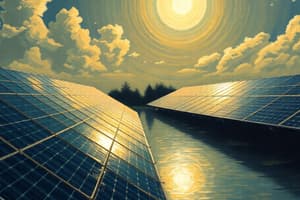Podcast
Questions and Answers
Which of these is NOT a method of using solar energy?
Which of these is NOT a method of using solar energy?
- Concentrated solar power
- Photovoltaic cells
- Solar thermal energy
- Wind power (correct)
What does the term 'photovoltaic' refer to in the context of solar energy?
What does the term 'photovoltaic' refer to in the context of solar energy?
- The process of converting heat energy into electrical energy
- The process of converting light energy into heat energy
- The process of converting light energy into electrical energy (correct)
- The process of converting electrical energy into light energy
How does solar thermal energy work?
How does solar thermal energy work?
- It uses mirrors to reflect sunlight and heat up water (correct)
- It uses semiconductors to convert light into electricity
- It uses wind turbines to generate electricity
- It uses geothermal energy to generate electricity
What is a key advantage of using concentrated solar power?
What is a key advantage of using concentrated solar power?
What is a potential drawback of using solar energy?
What is a potential drawback of using solar energy?
Flashcards
Solar Panels
Solar Panels
Devices that convert sunlight directly into electricity using photovoltaic cells.
Solar Thermal Energy
Solar Thermal Energy
A method that uses sunlight to heat fluids, which can then be used for heating or electricity generation.
Concentrated Solar Power
Concentrated Solar Power
Technology that uses mirrors or lenses to concentrate a large area of sunlight, generating heat to produce electricity.
Solar Water Heating
Solar Water Heating
Signup and view all the flashcards
BIPV (Building-Integrated Photovoltaics)
BIPV (Building-Integrated Photovoltaics)
Signup and view all the flashcards
Study Notes
Photovoltaic (PV) Systems
- Solar panels convert sunlight directly into electricity
- PV panels consist of semiconductor materials (typically silicon)
- Sunlight excites electrons in the material, creating an electric current
- Different types of PV technologies exist, including monocrystalline, polycrystalline, and thin-film
- Efficiency varies depending on the type and manufacturing process
- Systems can be installed on rooftops, ground mounts, or integrated into buildings
- Inverters are crucial for converting DC electricity from solar panels into AC electricity usable by the grid or home appliances
- PV systems can be "grid-tied" (connected to the electricity grid) or "off-grid" (independent of the grid)
Concentrated Solar Power (CSP)
- CSP systems use mirrors or lenses to concentrate sunlight onto a receiver
- The concentrated heat is then used to generate steam
- The steam drives a turbine connected to a generator, producing electricity
- Different types of CSP technologies exist, including parabolic trough, solar tower, and linear Fresnel reflector
- Higher temperature and pressure from focusing sunlight is key to efficient energy generation
- Storage of thermal energy allows CSP plants to generate electricity even at night or during cloudy periods
Solar Thermal Systems
- Solar thermal systems use sunlight to heat water or air
- This heated water or air can be used for various applications like domestic hot water, space heating, or industrial processes
- Flat-plate collectors are common for residential hot water heating, utilizing simple designs to absorb and transfer solar warmth
- Evacuated tube collectors are utilized in situations demanding higher temperatures or where climate conditions might be more challenging
- Energy from sunshine is utilized to heat fluids within the system, generating the required temperature
- Materials selected and the design of the system determines its efficiency in accumulating and transferring solar energy
Passive Solar Design
- Passive solar design integrates solar energy into building design and construction
- Features like south-facing windows, overhangs, and thermal mass passively collect and store solar heat
- Reduces reliance on active solar energy collection systems by maximizing usable solar heat within a building's structure
- Minimizes reliance on conventional heating and cooling systems, fostering energy efficiency
- By strategically placing windows and shading elements, heat gain and retention is enhanced during winter months, and heat loss during summer is reduced, resulting in substantial energy savings.
Other Applications of Solar Energy
- Solar water heating systems are used for domestic hot water
- Solar cookers use sunlight to directly heat food
- Solar dryers are used for drying crops, fruits, or grains.
- Solar desalination is used to treat saltwater for drinking purposes
- Solar stills are specifically designed devices for purifying water using a distillation method employing solar energy, focusing on using solar radiation to create a change in temperature to vaporize water from its liquid state and then condense it back into a pure water form
- Solar energy is increasingly being used in remote areas where access to the grid is limited.
Challenges and Considerations
- Solar energy's intermittency (dependence on sunlight) requires energy storage solutions or backup systems.
- High upfront costs of photovoltaic (PV) and concentrated solar power (CSP) systems might be a barrier to adoption.
- Environmental impact of solar panel manufacturing should be considered.
- Locational factors like sunlight availability and temperature in the region are important considerations when planning implementations.
- Land area requirements can be substantial for large-scale solar farms.
- Maintenance and repair of the equipment is an important concern, especially given the long lifespan of solar energy equipment.
Studying That Suits You
Use AI to generate personalized quizzes and flashcards to suit your learning preferences.




